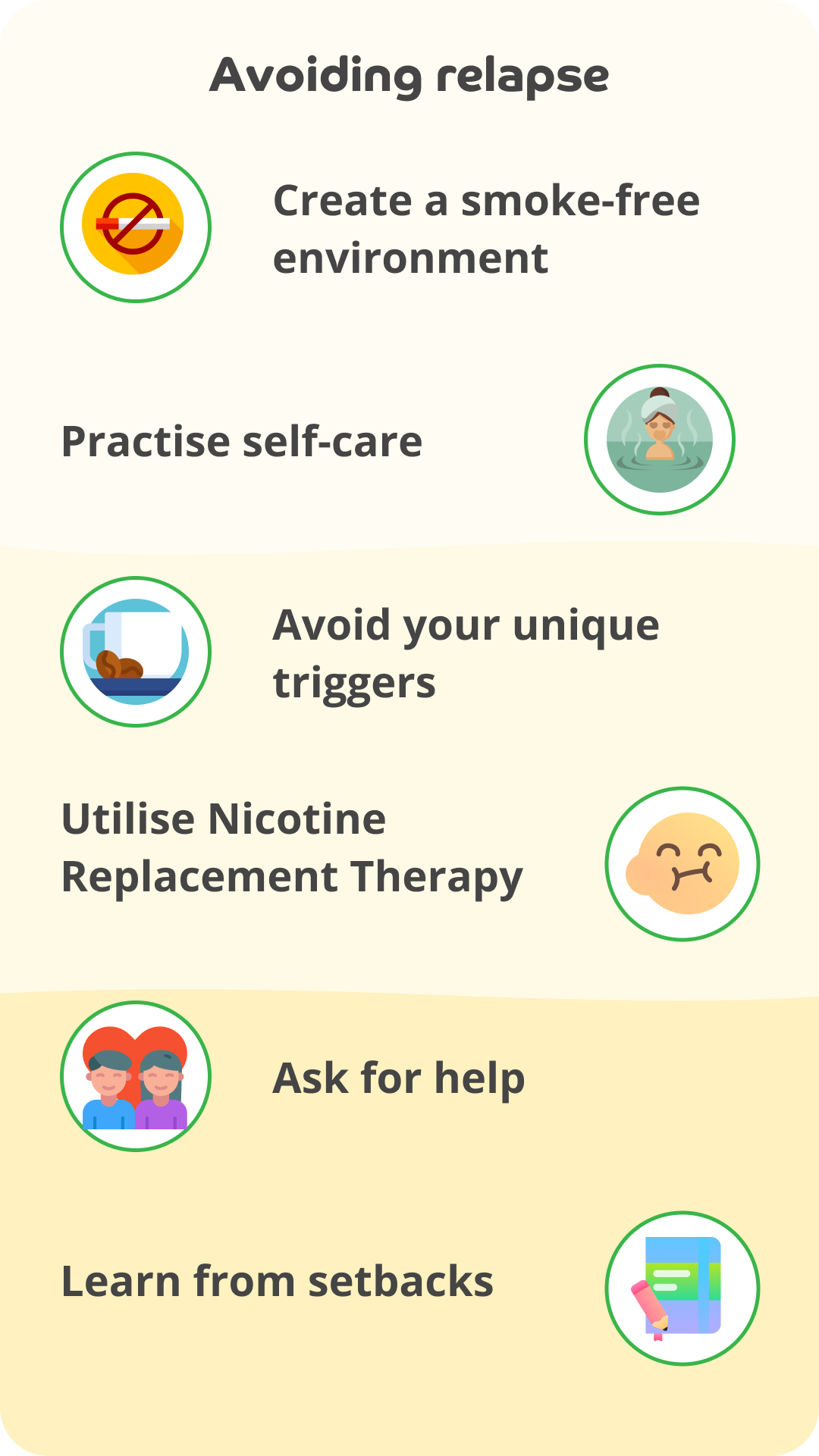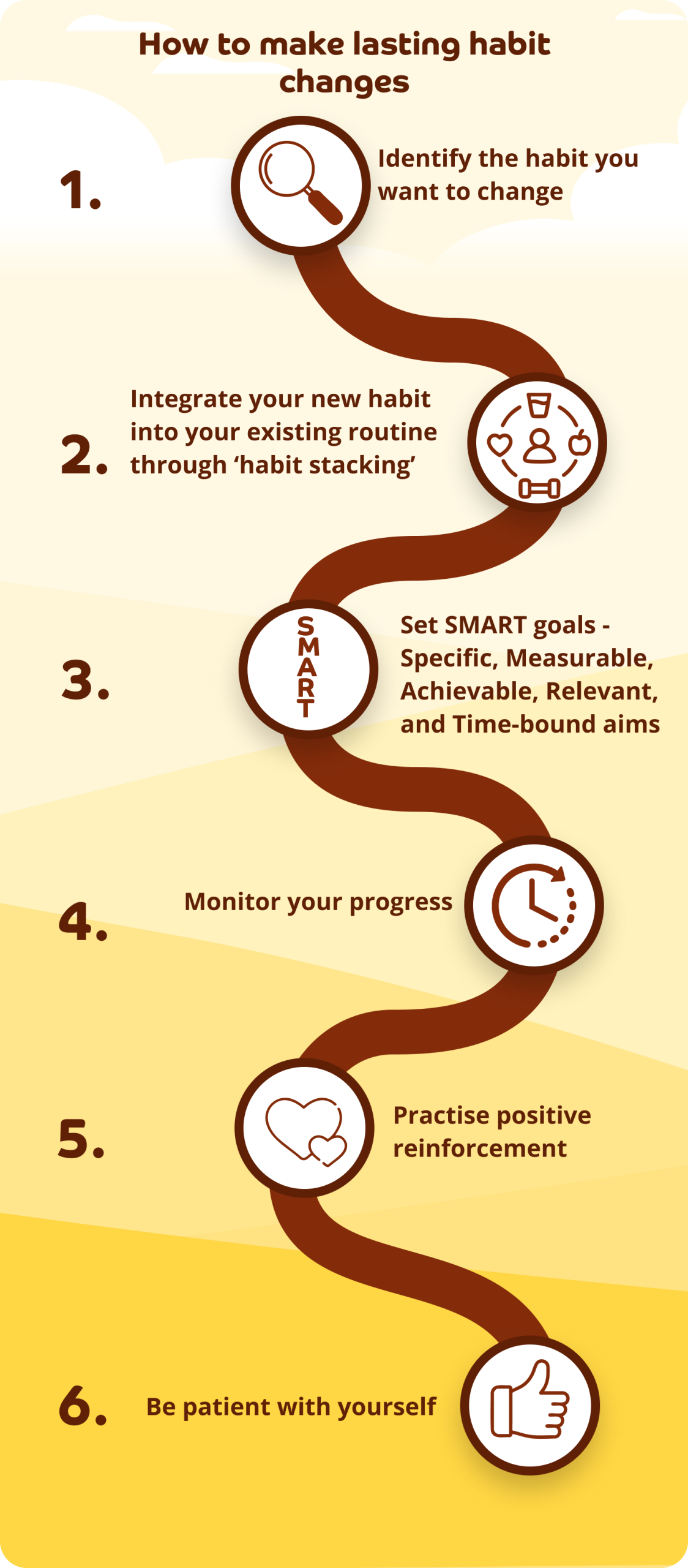Quitting smoking is a remarkable achievement – congratulations for kicking the habit! However, the journey doesn’t end there. Maintaining your smoke-free status requires ongoing commitment and effective strategies to navigate cravings and avoid triggers. This article outlines essential approaches to help you stay smoke-free, reinforcing your health and wellbeing, while also exploring the theory behind making lasting habit changes.
Read on to explore different ways to avoid a smoking relapse.
Create a smoke-free environment
One of the most effective ways to maintain your smoke free status is by creating a smoke-free environment. This means removing cigarettes and tobacco products from places where you regularly spend a lot of time like your home and car. Consider creating a space where you and your loved ones can enjoy activities without the presence of smoking.
Avoid places and activities that are associated with smoking. If certain environments trigger the urge to smoke, make a conscious effort to steer clear of them. Instead, explore public places that enforce tobacco-free policies, such as parks, restaurants, and cafes. These environments can provide a supportive backdrop for your smoke-free lifestyle.
Practise self-care
Taking care of your physical and mental health is crucial in your journey to remain smoke free. Focus on a healthy diet that includes plenty of fruit, vegetables, and wholegrains. Eating well not only strengthens your body but can also help manage weight gain, which is a common concern after quitting.
Ensuring you get enough sleep, is also key to avoiding a smoking relapse as fatigue can heighten cravings and reduce your ability to cope with stress. Staying hydrated by drinking plenty of water is also essential for overall health and can help curb cravings.
Regular exercise plays a significant role in maintaining your smoke-free status. Physical activity can boost your mood, reduce stress, and distract you from cravings. Aim for activities that you enjoy, whether it’s running, dancing, cycling, or playing a sport.
Avoid triggers
Identifying your personal smoking triggers that may lead to cravings is essential in learning how to deal with them. The same can be said for understanding that every habit is made up of a cue, a routine, and a reward – by identifying these elements in your smoking habit, you can more effectively change it. Remind yourself that cravings are temporary and will pass if you allow them to. When you feel the urge to smoke, consider delaying your response. This simple act can provide you with the time to assess your craving and choose a healthier coping mechanism.
In moments of temptation, practice deep breathing to calm your mind and body. Engaging in distractions, such as listening to music, reading a book, or exercising, can also help shift your focus away from cravings.
Practise self-care
Taking care of your physical and mental health is crucial in the journey to remain smoke-free. Focus on a healthy diet that includes plenty of fruits, vegetables, and wholegrains. Eating well not only strengthens your body but can also help manage weight gain, which is a common concern after quitting.
Ensuring you get enough sleep, is also key to avoiding a smoking relapse as fatigue can heighten cravings and reduce your ability to cope with stress. Staying hydrated by drinking plenty of water is also essential for overall health and can help curb cravings.
Regular exercise plays a significant role in maintaining your smoke-free status. Physical activity can boost your mood, reduce stress, and distract you from cravings. Aim for activities that you enjoy, whether it’s running, dancing, cycling, or playing a sport.
Utilise Nicotine Replacement Therapies
If you find yourself struggling with cravings or fear weight gain, consider using nicotine replacement therapies (NRTs). NRTs can help control cravings and withdrawal symptoms, making it easier to maintain your smoke-free status. Options include patches, gum, lozenges, sprays and inhalers, which provide a controlled dose of nicotine without the harmful chemicals found in cigarettes.
If you have questions or concerns about using NRTs, don’t hesitate to talk to your doctor or healthcare provider about other medications that may assist you in your journey.
Ask for help
Support is a crucial part of maintaining your smoke-free status. Reach out to friends and family for encouragement, and let them know how they can help you. Their support can make a significant difference in your ability to cope with cravings.
Engaging with local Stop Smoking Services, the NHS Smokefree Helpline (free to call 0300 123 1044 and available in England) or online support groups can be combined with NRTs to help you stay smoke free.
You can also visit NHS for a free Personalised Quit Plan tailored to your needs. This resource offers valuable tools and tips to help you stay on track.
Learn from setbacks
If you experience a relapse, it’s important to remember that setbacks can be part of the quitting process.
Take a moment to reflect on what led to the relapse. Understanding the circumstances can help you develop stronger coping strategies for the future.
Avoid harsh self-judgment; instead, treat yourself with compassion and view the relapse as a learning opportunity.
Revisit your quit plan and make necessary adjustments to better prepare for similar situations in the future.
Consider reaching out to your support network for encouragement and accountability. By acknowledging the setback, reaffirming your commitment to being smoke free, and reminding yourself of the benefits of quitting, you can regain your momentum and continue on your path to a healthier, smoke-free life.

Making lasting habit changes
To successfully maintain your smoke-free status, you need to replace smoking with healthy habits. Understanding the theory behind habit change, will help with this.
- Start by identifying the habit you want to change – smoking – and break it down into manageable steps. Instead of attempting to overhaul your entire lifestyle at once, begin with small, achievable actions that gradually build up to a bigger change. For example, if you usually smoke during a coffee break, start by replacing that routine with a short walk or engaging in a different social activity.
- Integrate your new habit into an existing routine through “habit stacking”. For instance, if you enjoy reading in the evening, stack the new habit of practicing deep breathing exercises for a few minutes right after you finish your reading. This connection can reinforce the new behaviour and make it easier to remember and perform.
- Setting SMART goals – Specific, Measurable, Achievable, Relevant, and Time-bound – will help you stay motivated and focused. For instance, you might set a goal to reduce your cravings by practicing a new coping strategy, like deep breathing, at least three times a week for one month. This approach makes your objectives clear and gives you a timeline to work with.
- Monitoring your progress is crucial in the habit change process. Use a habit tracker or calendar to visually monitor your smoke-free days and any coping strategies you implement. For instance, you could mark each day you successfully resist the urge to smoke or track how often you engage in alternative activities instead of smoking.
- Positive reinforcement plays a significant role in habit formation. Reward yourself for completing your new habit to strengthen the neural pathways associated with it. If you manage to stay smoke free for a week, treat yourself to something special – perhaps a nice meal or a small gift that acknowledges your hard work.
- Lastly, be patient. Changing habits takes time and consistency; don’t get discouraged by setbacks. If you find yourself reaching for a cigarette again, consider what triggered that response. Each effort you make to resist smoking brings you closer to a smoke-free life, reinforcing your commitment to long-term change.

Maintaining a smoke-free lifestyle requires dedication, self-awareness, and effective strategies. By creating a supportive environment, practicing self-care, avoiding triggers, utilising nicotine replacement therapies, and asking for support, you can thrive in your journey to remain smoke free. Remember, each day without smoking is a victory, and the benefits to your health and wellbeing are profound.
For additional support and resources, consider contacting your local NHS Stop Smoking Service or visiting the following resources:
- NHS: What Could Happen When You Quit Smoking
- Cancer.gov: Withdrawal Fact Sheet
- NHS Inform: Stopping Smoking After a Relapse
For more tips and ideas to build healthier habits which lead to improved wellness, download the Evergreen Life app, if you haven’t already.
- Facebook (n.d.) Smokefree Quit Smoking Support Group. [online] Available here.
- National Cancer Institute (2022) Tips for Coping with Nicotine Withdrawal and Triggers When You Decide to Quit Tobacco. [online] Available here.
- NHS Better Health (n.d.) Find your local Stop Smoking Service. [online] Available here.
- NHS Better Health (n.d.) Get a free Personal Quit Plan. [online] Available here.
- NHS Better Health (n.d.) What could happen when you quit smoking. [online] Available here.
- NHS Inform (2025) Stopping smoking after a relapse. [online] Available here.





